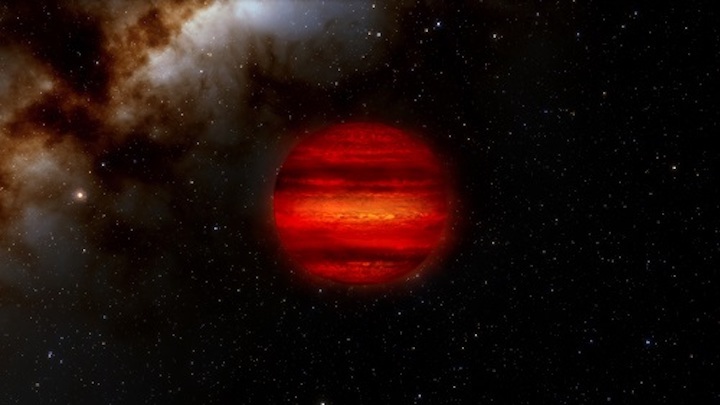9.04.2021

Brown Dwarf Illustration. Brown dwarfs are often called “failed stars.” They form like stars but are not massive enough to fuse hydrogen into helium as stars do. More like giant planets, brown dwarfs can often have storms in their atmospheres, as depicted in this illustration. Astronomers have recently discovered three brown dwarfs that spin faster than any other ever discovered. Each one completes a single rotation in roughly an hour, about 10 times faster than normal. Credit: NOIRLab/NSF/AURA/J. da Silva
Gemini North observations help set rotational speed limit for brown dwarfs.
Astronomers at Western University have discovered the most rapidly rotating brown dwarfs known. They found three brown dwarfs that each complete a full rotation roughly once every hour. That rate is so extreme that if these “failed stars” rotated any faster, they could come close to tearing themselves apart. Identified by NASA’s Spitzer Space Telescope, the brown dwarfs were then studied by ground-based telescopes including Gemini North, which confirmed their surprisingly speedy rotation.
Three brown dwarfs have been discovered spinning faster than any other found before. Astronomers at Western University in Canada first measured the rotation speeds of these brown dwarfs using NASA’s Spitzer Space Telescope and confirmed them with follow-up observations with the Gemini North telescope on Maunakea in Hawai‘i and the Carnegie Institution for Science’s Magellan Baade telescope in Chile. Gemini North is one of the pair of telescopes that make up the international Gemini Observatory, a Program of NSF’s NOIRLab.
“We seem to have come across a speed limit on the rotation of brown dwarfs,” said Megan Tannock, the Western University physics and astronomy graduate student who led the discovery. “Despite extensive searches, by our own team and others, no brown dwarfs have been found to rotate any faster. In fact, faster spins may lead to a brown dwarf tearing itself apart.”
Brown dwarfs are, simply put, failed stars. They form like stars but are less massive and more like giant planets [1].
Tannock and Western University astronomer Stanimir Metchev worked with international collaborators to find three rapidly rotating brown dwarfs spinning around their axes once every hour. This is approximately 10 times faster than normal [2], and about 30 percent faster than the most rapid rotations previously measured in such objects.
The astronomers used large ground-based telescopes, Gemini North in Hawai‘i and Magellan Baade in Chile, to confirm the rapid rotations. They did this by measuring alterations in the brown dwarfs’ light caused by the Doppler effect and using a computer model to match those alterations to spin rates [3]. The researchers found that these brown dwarfs spin with speeds of about 350,000 kilometers per hour (around 220,000 miles per hour) at their equator, which is 10 times faster than Jupiter.
“These unusual brown dwarfs are spinning at dizzying speeds,” said Sandy Leggett, an astronomer at Gemini North who studies brown dwarfs. “At about 350,000 kilometers per hour, the relatively weak gravity of the brown dwarfs is barely holding them together. This exciting discovery by the Tannock team has identified rotational limits beyond which these objects may not exist.”
The team first identified the rapid rotation rates by using NASA’s Spitzer Space Telescope to measure how quickly the brightness of the objects varied. “Brown dwarfs, like planets with atmospheres, can have large weather storms that affect their visible brightness,” explained Metchev. “The observed brightness variations show how frequently the same storms are seen as the object spins, which reveals the brown dwarf’s spin period.”
The team’s results will appear in an upcoming issue of The Astronomical Journal.
Notes
[1] There are four known giant planets in the Solar System: Jupiter, Saturn, Uranus, and Neptune.
[2] Stars, brown dwarfs, and planets generally spin around their axis once every 10 hours or more slowly. For example, Earth spins around its axis once every 24 hours while Jupiter and Saturn take about 10 hours. The Sun spins around its axis on average every 27 days. The Sun’s rotation rate varies with latitude, with its equatorial regions completing a rotation in about 25 days and the polar regions rotating once in approximately 35 days.
[3] As each brown dwarf rotates, light from the hemisphere turning toward us appears blueshifted while light from the hemisphere turning away from us appears redshifted because of the Doppler effect. This causes absorption lines in the brown dwarf’s spectrum to appear broadened (stretched both toward the red end of the spectrum and the blue end of the spectrum). By matching this broadening to a computer model, the astronomers determined how fast each brown dwarf is spinning.
Quelle: The Gemini Observatory
